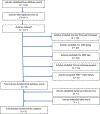Measuring change in facial emotion recognition in individuals with autism spectrum disorder: A systematic review
- PMID: 32551983
- PMCID: PMC11078255
- DOI: 10.1177/1362361320925334
Measuring change in facial emotion recognition in individuals with autism spectrum disorder: A systematic review
Abstract
Children and adults with autism spectrum disorder show difficulty recognizing facial emotions in others, which makes social interaction challenging. While there are many treatments developed to improve facial emotion recognition, there is no agreement on the best way to measure such abilities in individuals with autism spectrum disorder. The purpose of this review is to examine studies that were published between January 1998 and November 2019 and have measured change in facial emotion recognition to evaluate the effectiveness of different treatments. Our search yielded 65 studies, and within these studies, 36 different measures were used to evaluate facial emotion recognition in individuals with autism spectrum disorder. Only six of these measures, however, were used in different studies and by different investigators. In this review, we summarize the different measures and outcomes of the studies, in order to identify promising assessment tools and inform future research.
Keywords: autism spectrum disorder; facial emotion recognition; intervention; measurement.
Figures
Similar articles
-
Emotion recognition in autism spectrum condition during the COVID-19 pandemic.Autism. 2024 Jul;28(7):1690-1702. doi: 10.1177/13623613231203306. Epub 2023 Oct 26. Autism. 2024. PMID: 37882152 Free PMC article.
-
Misinterpretation of facial expressions of emotion in verbal adults with autism spectrum disorder.Autism. 2015 Apr;19(3):308-15. doi: 10.1177/1362361314520755. Epub 2014 Feb 17. Autism. 2015. PMID: 24535689 Free PMC article.
-
Effects of Emotional Music on Facial Emotion Recognition in Children with Autism Spectrum Disorder (ASD).J Autism Dev Disord. 2021 Sep;51(9):3256-3265. doi: 10.1007/s10803-020-04781-0. Epub 2020 Nov 17. J Autism Dev Disord. 2021. PMID: 33201423
-
Establishing the Relationship Between Attention Deficit Hyperactivity Disorder and Emotional Facial Expression Recognition Deficit: A Systematic Review.J Atten Disord. 2023 Sep;27(11):1181-1195. doi: 10.1177/10870547231154901. Epub 2023 Feb 26. J Atten Disord. 2023. PMID: 36843351 Free PMC article.
-
Facial Expression Production and Recognition in Autism Spectrum Disorders: A Shifting Landscape.Psychiatr Clin North Am. 2021 Mar;44(1):125-139. doi: 10.1016/j.psc.2020.11.010. Psychiatr Clin North Am. 2021. PMID: 33526234 Review.
Cited by
-
Autistic and non-autistic individuals show the same amygdala activity during emotional face processing.Mol Autism. 2024 Jan 10;15(1):2. doi: 10.1186/s13229-024-00582-9. Mol Autism. 2024. PMID: 38200601 Free PMC article.
-
Altered interpersonal distance regulation in autism spectrum disorder.PLoS One. 2023 Mar 31;18(3):e0283761. doi: 10.1371/journal.pone.0283761. eCollection 2023. PLoS One. 2023. PMID: 37000718 Free PMC article.
-
Reasoning More Efficiently with Primary Knowledge Despite Extraneous Cognitive Load.Evol Psychol. 2024 Apr-Jun;22(2):14747049241252694. doi: 10.1177/14747049241252694. Evol Psychol. 2024. PMID: 38840333 Free PMC article.
-
Effects of Transcranial Direct Current Stimulation on Social Attention Patterns and Emotion Recognition Ability in Male Adolescents with Autism Spectrum Disorder.J Clin Med. 2023 Aug 26;12(17):5570. doi: 10.3390/jcm12175570. J Clin Med. 2023. PMID: 37685637 Free PMC article.
-
How White American Children Develop Racial Biases in Emotion Reasoning.Affect Sci. 2022 Apr 1;3(1):21-33. doi: 10.1007/s42761-022-00111-y. eCollection 2022 Mar. Affect Sci. 2022. PMID: 36046098 Free PMC article.
References
-
- Adolphs R. (2002). Neural systems for recognizing emotion. Current Opinion in Neurobiology, 12(2), 169–177. - PubMed
-
- Ashwin C, Chapman E, Colle L, & Baron-Cohen S. (2006). Impaired recognition of negative emotions in autism: A test of the amygdala theory. Social Neuroscience, 1(3–4), 349–363. - PubMed
-
- Baron-Cohen S, Golan O, Wheelwright S. & Hill JJ (2004). Mind Reading: The Interactive Guide to Emotions. London: Jessica Kingsley Limited
Publication types
MeSH terms
Grants and funding
LinkOut - more resources
Full Text Sources
Medical


